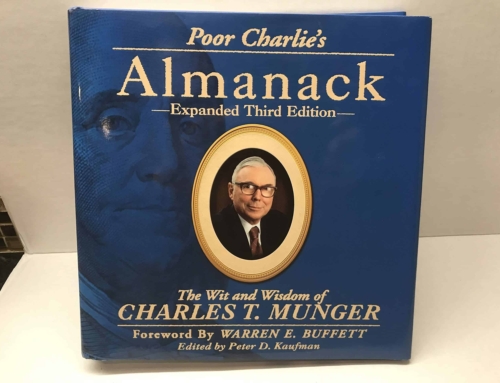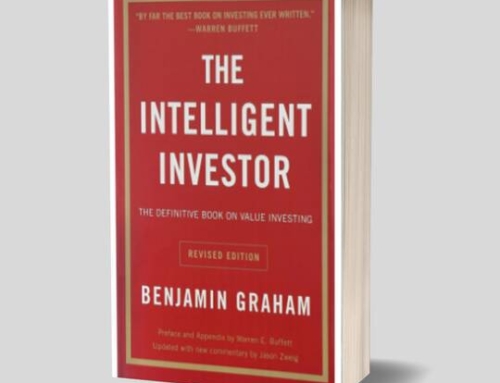One Up On Wall Street – Summary
Have you ever talked to someone and when you mentioned that you’re an investor in the stock market, you’ve been asked this? Aren’t there plenty of professionals out there who dedicate their lives earning money in the stock market? What makes you think that you can beat those guys at their own game? I know I’ve been asked this on multiple occasions and it’s an important topic.
Can the amateur investor earn money while there are so-called professionals in the same market? Could it even be so that the individual investor has the upper hand? In ‘One up on Wall Street’, the legendary investor Peter Lynch reveals how his amateur approach to investing has led him to become one of the most successful investors of all time. Peter Lynch ran the Fidelity Magellan Fund between 1977 and 1990.
During that time, he beat the markets by a huge margin, as he outpaced the S&P 500 11 out of 13 years, averaging over 29% average annual return. He also authored several top-selling books on investing, including One Up on Wall Street and Beating the Street, and has been a generous contributor to the Boston community, the Catholic Schools Foundation, and the Inner-City Scholarship Fund.
We will now present five of his greatest findings from the book “One Up on Wall Street”.
Takeaway No 1.
Why can the individual investor beat the Pros? Surely the amateur doesn’t stand a chance against the might of Wall Street. Doesn’t Wall Street have a ton of analysts from the fanciest Ivy league schools working 80 hours every week to find bargain stocks? Surely there can’t be any left for the amateurs, right? According to Peter Lynch, this assumption is dead wrong. The professional investor has many disadvantages compared to the amateur. Here are a few of them.
- Size:- A successful money manager will naturally attract a lot of capital and more capital means fewer opportunities. For instance, a $10 billion fund cannot invest in a company with a market cap of $10 million and expect the investment to have a meaningful impact on the fund’s overall performance. Mediocrity is the safest play. There’s a saying on Wall Street that you’ll never lose your job, losing your client’s money in an IBM. What it means is that if you’re just another sheep in the herd, you’ll get to keep your job. Remember that fund managers have their own agendas and that they too are employees with jobs that aren’t guaranteed.
- There’s a lot of explaining: Fund managers tend to spend about 25% of their time explaining to various stakeholders why they made certain decisions. Unfortunately, stocks aren’t sympathetic enough to yield an extra 25% for this increased effort.
- Capital is dependent on clients: Asset fund managers invest other people’s money. There are also a bunch of people who decide how much money the manager has at his disposal. They tend to pull back their money during bad markets and put in more of it during a boom, which is exactly the opposite of what one should do. This leaves the manager with the following dilemma – He has a lot of money to invest when everything is expensive and too little of it when everything is cheap. Does the individual investor have any of these disadvantages? No. The amateur investor often has a great advantage over the professionals, which we’ll discuss in the next takeaway.
Takeaway No 2.
- If you like the store, chances are you’ll love the stock:
If you’re a software engineer, a cashier at the local mall, a professional musician, a surfer, a fast-food addict, or a crazy cat lady, you have an edge over Wall Street. Wait, let me explain. We all have certain industries, products, and services that we know more about than the average person does. Perhaps we know more about the fashion industry because we work at a local clothing store. We know more about the gaming industry because we consume games as our primary leisure activity. The point is that we all have valuable information about publicly-listed companies in our everyday life and this is information that Wall Street either doesn’t know of yet or had to spend hundreds of hours of market research to realize. Peter Lynch famously said that if you like the store, chances are that you’ll love the stock. Think about it. Which products do you enjoy and use from publicly listed companies? Here’s a list of some of mine.
- Spotify: An awesome Swedish music streaming service, which I use for one to two hours a day. I love to use it when I work out and I’ve spent about 120 bucks on it during the last year
- Pepsi: This summer the new flavor Pepsi lime was released in Sweden and I’ve been a complete addict to it. I probably drink three of them every week or so. So I spend more than 200 bucks on these every year.
- Amazon: Well, I’ve probably been their best customer of 2018 as I buy all the books that I read for this channel. Not only that, but I prefer buying both the Kindle and the audio if possible, as I found that I can finish the books in half the time, that way. Every year, I spend $1,500 or more on this service.
When you’re looking for investment opportunities, this way, you must always remember to check how much the product or service that you enjoy affects the bottom line for the company. For example, I am sure I am addicted to the new Pepsi lime flavor, but let’s say that this product only makes up 2% of the company’s total profits. Then it doesn’t make sense for me to buy Pepsi based on me loving the Pepsi line.
Takeaway No 3.
The six categories of stock: All investment opportunities aren’t created equal. To lump them all together and treat them accordingly would be a foolish and not so profitable strategy. Peter Lynch argues that there are 6 different categories of stock investments. These are :
- Slow Growers: This Company is typically large and operates in a mature industry. The growth of the company is expected to be in the low single digits of percentages. If you invest in such a company, you typically do it for the dividends. Lynch doesn’t like this category of stocks too much as he thinks that if the company isn’t going anywhere fast, neither will its stock price.
- Stalwarts: The Stalwarts are in-between. They’re not exactly the stock market equivalent of cheetahs, but they are no snails either. An earnings growth rate of 10 to 12% per year is standard for this category under normal conditions. You want to sell these companies off if they make a quick 30 to 50 gain.
- Fast Growers: These are aggressive new enterprises growing at 20% or more. They’re often priced thereafter, but if you can conclude that a company is likely to be able to keep up the growth for several years, it can be a great investment. Always remember to verify your assumptions regarding the growth rate, though. For instance, if Amazon can keep up its revenue growth rate of 30% per year for the next 10 years, its revenue will be equal to the GDP of France in 2029. Is this reasonable?
- Cyclicals: are companies whose revenues and profits rise and fall with the business cycle. Typically they produce services and products that the consumers will postpone consumption of in times of financial uncertainty. An example is the automobile space. People don’t necessarily have to switch cars every six years or so, even if they prefer to. Timing is everything here. If you can identify early signs of a booming or busting cycle, you’ll have the advantage.
- Turnarounds: The turnarounds are potential fatalities, companies with declining earnings, and or problematic balance sheets. If the company doesn’t go down and instead manages to flourish once again, stock owners are awarded thereafter. An interesting characteristic about the turnarounds is that their ups and downs aren’t as related to the market in general, as the rest of the categories. A situation where a company has gotten a temporary bad reputation is usually a profitable turnaround case
- Asset plays:- Situations, where the value of the company indicates that the market has missed out on something valuable that the company owns, are asset plays. Such undervalued assets could be real estate, patents, natural resources, subscribers, or even company losses as these are deductible from future earnings. Benjamin Graham was a strong advocate of this approach. He famously looked for companies where the values of the assets were higher than the market cap of the stock. Then he just waited until the Stock market realized its mistake and corrected it.
The 6 categories are explained in much greater detail in the book. When using these categories one must understand that companies can belong to more than one of them at once. Also, companies don’t stay in the same category forever. Take McDonald’s for example, it’s gone from being a fast grower to a stalwart, to an asset play to a slow grower.
Takeaway No 4.
10 traits of the ten-bagger: A 10 bagger is the expression that Peter Lynch uses to describe a stock, which has appreciated 10 times your purchase price. If you have a few of these here in your investing lifetime, you’ll become a legend. Different types of stocks must be treated differently. As stated in the previous takeaway above, there are also similarities. Here are 10 positive signs for a stock, regardless of it being an asset play or a fast grower.
- The company name is dull or even better ridiculous: Such companies tend to be overlooked. The pros of Wall Street think twice before bragging about their recent investment. Maui land and Pineapple Company incorporated are examples of companies whose shares skyrocketed before Wall Street got to know their existence.
- It does something dull: Companies that are involved in waste recycling, production of livestock feed are often overlooked.
- It does something disagreeable: Better yet doing something dull is to do something disagreeable. Swedish Match is a good example, which is the producer of Swedish tobacco.
- Institutions don’t own it and it’s not followed by many analysts: Such companies haven’t been discovered yet by the big boys, which gives it an extra potential outside
- Something is depressing about it: The burial company service Corporation International is a classic example.
- The company’s industry isn’t growing: In the high-growth industries, thousands of people are constantly thinking about how they can grab a part of the market share. Stalling industries, on the other hand, aren’t as prone to competition.
- It’s got a niche: These are the companies with moats that Warren buffet is famously looking for.
- It has recurring revenues: The product is a subscription or something that is consumed so that the customers are forced to return for more.
- Insiders are buying: The insiders know more about the company than anyone else. When they are buying, you can be pretty sure that at the very least that the company isn’t going bankrupt soon.
- The company is buying back shares: If a company has faith in itself, it should invest in itself. Peter Lynch prefers Share Buybacks for dividends.
Takeaway No 5.
5 traits of the reversed ten-bagger: Of course there are also general traits that you don’t want to see in any type of company that you are investing in.
- It’s in a hot industry: As previously mentioned, everyone is looking for ways to get into the hot industries. Competition is typically a bad omen for profits.
- It’s the next thing: Be aware when someone expresses that it’s the next Amazon, the next Facebook or the next Google, or similar. Usually, it’s not.
- The company is diversifying: Some call it diversification, but Lynch likes to refer to it as di-worsification. If the company is acquiring other companies in unrelated industries, stay away.
- It’s dependent on a single customer: Some companies are relying on one customer for a significant share of profits. Usually, this is a weak bargaining position to be in, and the company can potentially be squeezed by this only customer
- It’s a whisper stock: These are the long shots. Often thought of as being on the brink of doing something miraculous, like curing every type of cancer, completely removing any addiction, or creating world peace.
One up on Wall Street recap, the individual investor can beat the pros at their own game because the game is rigged in the favor of the amateur. Use your consumption habits and your 9 to 5 to identify investment opportunities in companies where you have an edge over the rest of the investing community. All investment opportunities aren’t created equal. You can usually categorize them into one or more of the following six Slow Growers, Stalwarts, False Growers, Cyclicals Turnarounds, and or Asset Play. There are generally positive traits of a stock such as Adult Business, Reoccurring Revenues, and Insider Buying. And there are also general negative traits such as Diversification and Dependency on a single customer.
NOTE: This article is inspired by the Swedish Investor’s interpretation of the book. We thank him for all the awesome work he has done.
One Up On Wall Street – Summary
Have you ever talked to someone and when you mentioned that you’re an investor in the stock market, you’ve been asked this? Aren’t there plenty of professionals out there who dedicate their lives earning money in the stock market? What makes you think that you can beat those guys at their own game? I know I’ve been asked this on multiple occasions and it’s an important topic.
Can the amateur investor earn money while there are so-called professionals in the same market? Could it even be so that the individual investor has the upper hand? In ‘One up on Wall Street’, the legendary investor Peter Lynch reveals how his amateur approach to investing has led him to become one of the most successful investors of all time. Peter Lynch ran the Fidelity Magellan Fund between 1977 and 1990.
During that time, he beat the markets by a huge margin, as he outpaced the S&P 500 11 out of 13 years, averaging over 29% average annual return. He also authored several top-selling books on investing, including One Up on Wall Street and Beating the Street, and has been a generous contributor to the Boston community, the Catholic Schools Foundation, and the Inner-City Scholarship Fund.
We will now present five of his greatest findings from the book “One Up on Wall Street”.
Takeaway No 1.
Why can the individual investor beat the Pros? Surely the amateur doesn’t stand a chance against the might of Wall Street. Doesn’t Wall Street have a ton of analysts from the fanciest Ivy league schools working 80 hours every week to find bargain stocks? Surely there can’t be any left for the amateurs, right? According to Peter Lynch, this assumption is dead wrong. The professional investor has many disadvantages compared to the amateur. Here are a few of them.
- Size:- A successful money manager will naturally attract a lot of capital and more capital means fewer opportunities. For instance, a $10 billion fund cannot invest in a company with a market cap of $10 million and expect the investment to have a meaningful impact on the fund’s overall performance. Mediocrity is the safest play. There’s a saying on Wall Street that you’ll never lose your job, losing your client’s money in an IBM. What it means is that if you’re just another sheep in the herd, you’ll get to keep your job. Remember that fund managers have their own agendas and that they too are employees with jobs that aren’t guaranteed.
- There’s a lot of explaining: Fund managers tend to spend about 25% of their time explaining to various stakeholders why they made certain decisions. Unfortunately, stocks aren’t sympathetic enough to yield an extra 25% for this increased effort.
- Capital is dependent on clients: Asset fund managers invest other people’s money. There are also a bunch of people who decide how much money the manager has at his disposal. They tend to pull back their money during bad markets and put in more of it during a boom, which is exactly the opposite of what one should do. This leaves the manager with the following dilemma – He has a lot of money to invest when everything is expensive and too little of it when everything is cheap. Does the individual investor have any of these disadvantages? No. The amateur investor often has a great advantage over the professionals, which we’ll discuss in the next takeaway.
Takeaway No 2.
- If you like the store, chances are you’ll love the stock:
If you’re a software engineer, a cashier at the local mall, a professional musician, a surfer, a fast-food addict, or a crazy cat lady, you have an edge over Wall Street. Wait, let me explain. We all have certain industries, products, and services that we know more about than the average person does. Perhaps we know more about the fashion industry because we work at a local clothing store. We know more about the gaming industry because we consume games as our primary leisure activity. The point is that we all have valuable information about publicly-listed companies in our everyday life and this is information that Wall Street either doesn’t know of yet or had to spend hundreds of hours of market research to realize. Peter Lynch famously said that if you like the store, chances are that you’ll love the stock. Think about it. Which products do you enjoy and use from publicly listed companies? Here’s a list of some of mine.
- Spotify: An awesome Swedish music streaming service, which I use for one to two hours a day. I love to use it when I work out and I’ve spent about 120 bucks on it during the last year
- Pepsi: This summer the new flavor Pepsi lime was released in Sweden and I’ve been a complete addict to it. I probably drink three of them every week or so. So I spend more than 200 bucks on these every year.
- Amazon: Well, I’ve probably been their best customer of 2018 as I buy all the books that I read for this channel. Not only that, but I prefer buying both the Kindle and the audio if possible, as I found that I can finish the books in half the time, that way. Every year, I spend $1,500 or more on this service.
When you’re looking for investment opportunities, this way, you must always remember to check how much the product or service that you enjoy affects the bottom line for the company. For example, I am sure I am addicted to the new Pepsi lime flavor, but let’s say that this product only makes up 2% of the company’s total profits. Then it doesn’t make sense for me to buy Pepsi based on me loving the Pepsi line.
Takeaway No 3.
The six categories of stock: All investment opportunities aren’t created equal. To lump them all together and treat them accordingly would be a foolish and not so profitable strategy. Peter Lynch argues that there are 6 different categories of stock investments. These are :
- Slow Growers: This Company is typically large and operates in a mature industry. The growth of the company is expected to be in the low single digits of percentages. If you invest in such a company, you typically do it for the dividends. Lynch doesn’t like this category of stocks too much as he thinks that if the company isn’t going anywhere fast, neither will its stock price.
- Stalwarts: The Stalwarts are in-between. They’re not exactly the stock market equivalent of cheetahs, but they are no snails either. An earnings growth rate of 10 to 12% per year is standard for this category under normal conditions. You want to sell these companies off if they make a quick 30 to 50 gain.
- Fast Growers: These are aggressive new enterprises growing at 20% or more. They’re often priced thereafter, but if you can conclude that a company is likely to be able to keep up the growth for several years, it can be a great investment. Always remember to verify your assumptions regarding the growth rate, though. For instance, if Amazon can keep up its revenue growth rate of 30% per year for the next 10 years, its revenue will be equal to the GDP of France in 2029. Is this reasonable?
- Cyclicals: are companies whose revenues and profits rise and fall with the business cycle. Typically they produce services and products that the consumers will postpone consumption of in times of financial uncertainty. An example is the automobile space. People don’t necessarily have to switch cars every six years or so, even if they prefer to. Timing is everything here. If you can identify early signs of a booming or busting cycle, you’ll have the advantage.
- Turnarounds: The turnarounds are potential fatalities, companies with declining earnings, and or problematic balance sheets. If the company doesn’t go down and instead manages to flourish once again, stock owners are awarded thereafter. An interesting characteristic about the turnarounds is that their ups and downs aren’t as related to the market in general, as the rest of the categories. A situation where a company has gotten a temporary bad reputation is usually a profitable turnaround case
- Asset plays:- Situations, where the value of the company indicates that the market has missed out on something valuable that the company owns, are asset plays. Such undervalued assets could be real estate, patents, natural resources, subscribers, or even company losses as these are deductible from future earnings. Benjamin Graham was a strong advocate of this approach. He famously looked for companies where the values of the assets were higher than the market cap of the stock. Then he just waited until the Stock market realized its mistake and corrected it.
The 6 categories are explained in much greater detail in the book. When using these categories one must understand that companies can belong to more than one of them at once. Also, companies don’t stay in the same category forever. Take McDonald’s for example, it’s gone from being a fast grower to a stalwart, to an asset play to a slow grower.
Takeaway No 4.
10 traits of the ten-bagger: A 10 bagger is the expression that Peter Lynch uses to describe a stock, which has appreciated 10 times your purchase price. If you have a few of these here in your investing lifetime, you’ll become a legend. Different types of stocks must be treated differently. As stated in the previous takeaway above, there are also similarities. Here are 10 positive signs for a stock, regardless of it being an asset play or a fast grower.
- The company name is dull or even better ridiculous: Such companies tend to be overlooked. The pros of Wall Street think twice before bragging about their recent investment. Maui land and Pineapple Company incorporated are examples of companies whose shares skyrocketed before Wall Street got to know their existence.
- It does something dull: Companies that are involved in waste recycling, production of livestock feed are often overlooked.
- It does something disagreeable: Better yet doing something dull is to do something disagreeable. Swedish Match is a good example, which is the producer of Swedish tobacco.
- Institutions don’t own it and it’s not followed by many analysts: Such companies haven’t been discovered yet by the big boys, which gives it an extra potential outside
- Something is depressing about it: The burial company service Corporation International is a classic example.
- The company’s industry isn’t growing: In the high-growth industries, thousands of people are constantly thinking about how they can grab a part of the market share. Stalling industries, on the other hand, aren’t as prone to competition.
- It’s got a niche: These are the companies with moats that Warren buffet is famously looking for.
- It has recurring revenues: The product is a subscription or something that is consumed so that the customers are forced to return for more.
- Insiders are buying: The insiders know more about the company than anyone else. When they are buying, you can be pretty sure that at the very least that the company isn’t going bankrupt soon.
- The company is buying back shares: If a company has faith in itself, it should invest in itself. Peter Lynch prefers Share Buybacks for dividends.
Takeaway No 5.
5 traits of the reversed ten-bagger: Of course there are also general traits that you don’t want to see in any type of company that you are investing in.
- It’s in a hot industry: As previously mentioned, everyone is looking for ways to get into the hot industries. Competition is typically a bad omen for profits.
- It’s the next thing: Be aware when someone expresses that it’s the next Amazon, the next Facebook or the next Google, or similar. Usually, it’s not.
- The company is diversifying: Some call it diversification, but Lynch likes to refer to it as di-worsification. If the company is acquiring other companies in unrelated industries, stay away.
- It’s dependent on a single customer: Some companies are relying on one customer for a significant share of profits. Usually, this is a weak bargaining position to be in, and the company can potentially be squeezed by this only customer
- It’s a whisper stock: These are the long shots. Often thought of as being on the brink of doing something miraculous, like curing every type of cancer, completely removing any addiction, or creating world peace.
One up on Wall Street recap, the individual investor can beat the pros at their own game because the game is rigged in the favor of the amateur. Use your consumption habits and your 9 to 5 to identify investment opportunities in companies where you have an edge over the rest of the investing community. All investment opportunities aren’t created equal. You can usually categorize them into one or more of the following six Slow Growers, Stalwarts, False Growers, Cyclicals Turnarounds, and or Asset Play. There are generally positive traits of a stock such as Adult Business, Reoccurring Revenues, and Insider Buying. And there are also general negative traits such as Diversification and Dependency on a single customer.
NOTE: This article is inspired by the Swedish Investor’s interpretation of the book. We thank him for all the awesome work he has done.







Leave A Comment